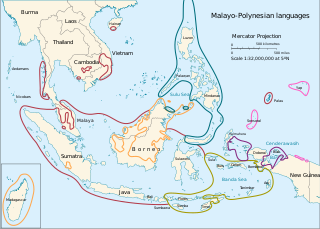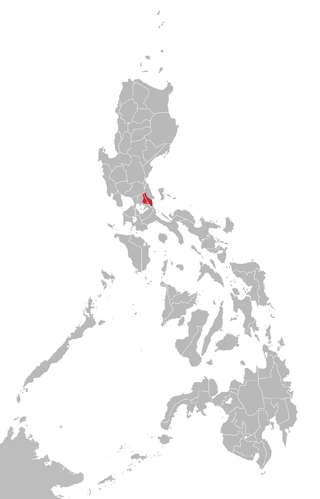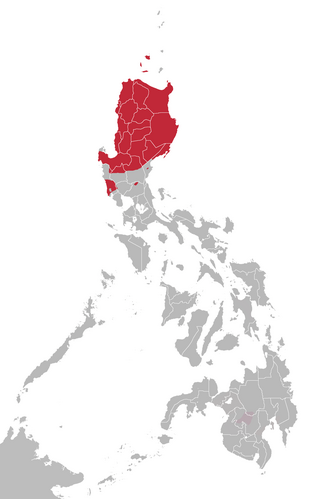Related Research Articles

The Malayo-Polynesian languages are a subgroup of the Austronesian languages, with approximately 385.5 million speakers. The Malayo-Polynesian languages are spoken by the Austronesian peoples outside of Taiwan, in the island nations of Southeast Asia and the Pacific Ocean, with a smaller number in continental Asia in the areas near the Malay Peninsula, with Cambodia, Vietnam and the Chinese island Hainan as the northwest geographic outlier. Malagasy, spoken on the island of Madagascar off the eastern coast of Africa in the Indian Ocean, is the furthest western outlier.

Calabarzon, sometimes referred to as Southern Tagalog and designated as Region IV‑A, is an administrative region in the Philippines. It is situated southeast of Metro Manila and is bordered by Manila Bay and the South China Sea to the west, Lamon Bay and the Bicol Region to the east, Tayabas Bay and the Sibuyan Sea to the south, and Central Luzon to the north. Comprising five provinces—Cavite, Laguna, Batangas, Rizal, and Quezon —and one highly urbanized city, Lucena, it is the most populous region in the Philippines, according to the 2020 census (PSA), with over 16.1 million inhabitants. It is also the country's second most densely populated region, after the National Capital Region. Calamba in Laguna serves as the regional center, while Antipolo in Rizal is the most populous city in the region

Aurora, officially the Province of Aurora, is a province in the Philippines located in the eastern part of Central Luzon region, facing the Philippine Sea. Its capital is Baler and borders, clockwise from the south, the provinces of Quezon, Bulacan, Nueva Ecija, Nueva Vizcaya, Quirino, and Isabela. Maria Aurora is the only landlocked town in the province and yet, the most populous. It is the only province in Central Luzon that has no chartered cities.

Southern Tagalog, designated as Region IV, was an administrative region in the Philippines that comprised the current regions of Calabarzon and Mimaropa, the province of Aurora in Central Luzon, and most of the National Capital Region. It was the largest region in the Philippines in terms of both land area and population. After its partition on May 17, 2002, Southern Tagalog continues to exist as a cultural-geographical region.

The Bisayan languages or Visayan languages are a subgroup of the Austronesian languages spoken in the Philippines. They are most closely related to Tagalog and the Bikol languages, all of which are part of the Central Philippine languages. Most Bisayan languages are spoken in the whole Visayas section of the country, but they are also spoken in the southern part of the Bicol Region, islands south of Luzon, such as those that make up Romblon, most of the areas of Mindanao and the province of Sulu located southwest of Mindanao. Some residents of Metro Manila also speak one of the Bisayan languages.
The Central Philippine languages are the most geographically widespread demonstrated group of languages in the Philippines, being spoken in southern Luzon, Visayas, Mindanao, and Sulu. They are also the most populous, including Tagalog, Bikol, and the major Visayan languages Cebuano, Hiligaynon, Waray, Kinaray-a, and Tausug, with some forty languages all together.

Remontado, also known in literature as Sinauna, Kabalat, Remontado Dumagat, and more commonly by the autonym Hatang-Kayi, is a Malayo-Polynesian language spoken in Tanay, Rizal, General Nakar, Quezon, Rodriguez, Rizal and Antipolo, in the Philippines. It is one of the Philippine Negrito languages. It is a moribund language.
The Greater Central Philippine languages are a proposed subgroup of the Austronesian language family, defined by the change of Proto-Malayo-Polynesian *R to *g. They are spoken in the central and southern parts of the Philippines and in northern Sulawesi, Indonesia. This subgroup was first proposed by Robert Blust (1991) based on lexical and phonological evidence, and is accepted by most specialists in the field.
The Mamanwa language is a Central Philippine language spoken by the Mamanwa people. It is spoken in the provinces of Agusan del Norte and Surigao del Norte in the Lake Mainit area of Mindanao, Philippines. It had about 5,000 speakers in 1990.
Arta is a highly endangered Negrito language of the northern Philippines.

Dupaningan Agta, or Eastern Cagayan Agta, is a language spoken by a semi-nomadic hunter-gatherer Negrito people of Cagayan and Isabela provinces in northern Luzon, Philippines. Its Yaga dialect is only partially intelligible.
Manide is a Philippine language spoken throughout the province of Camarines Norte in Bicol region and near the eastern edge of Quezon in Southern Tagalog of southern Luzon in the Philippines. Manide is spoken by nearly 4,000 Negrito people, most of whom reside in the towns of Labo, Jose Panganiban, and Paracale.
The Negrito peoples of the Philippines speak various Philippine languages. They have more in common with neighboring languages than with each other, and are listed here merely as an aid to identification.
Inagta Rinconada is a Bikol language spoken by a semi-nomadic hunter-gatherer Agta (Negrito) people of the Philippines. It is spoken to the east of Iriga City up to the shores of Lake Buhi. The language is largely intelligible with Mount Iraya Agta on the other side of the lake.

Southern Alta, is a distinctive Aeta language of the mountains of northern Philippines. Southern Alta is one of many endangered languages that risks being lost if it is not passed on by current speakers. Most speakers of Southern Alta also speak Tagalog.

Northern Alta is a distinctive Aeta language of the mountains of the Sierra Madre in Aurora province, Northern Philippines. Linguist Lawrence Reid reports two different Alta languages, Northern and Southern Alta, which form one of the high nodes of the Northern Luzon languages, together with the South-Central Cordilleran subgroup. Although the Alta languages are genetically related, they have a low level of mutual intelligibility.
Casiguran Dumagat Agta, also known as Casiguran Agta, is a Northeastern Luzon language spoken in the northern Philippines. It is spoken by around 610 speakers, most of whom live in the San Ildefonso Peninsula, across the bay from Casiguran, Aurora.
Kasiguranin (Casiguranin) is a Tagalogic language that is indigenous to the Casiguran town of Aurora in the northern Philippines. It is descended from an early Tagalog dialect that had borrowed heavily from Northeastern Luzon Agta languages, and, to a lesser extent, from Ilocano, Bikol languages, Kapampangan, Gaddang, Itawis, Ibanag, and Paranan, which were spoken by settlers from other parts of the Philippines.
Ati (Inati), or Binisaya nga Inati, is an Austronesian language of the island of Panay in the Philippines. The variety spoken in northern Panay is also called Sogodnin. The Ati people also speak Kinaray-a and Hiligaynon.

The Northern Luzon languages are one of the few established large groups within Philippine languages. These are mostly located in and around the Cordillera Central of northern Luzon in the Philippines. Among its major languages are Ilocano, Pangasinan and Ibanag.
References
- ↑ Umiray Dumaget at Ethnologue (18th ed., 2015) (subscription required)
- ↑ Umiray Dumaget is under Greater Central Philippine language family according to Glottolog and Ethnologue.
- ↑ Himes 2002:275–276
- ↑ Reid, Lawrence A. 1994. "Possible Non-Austronesian Lexical Elements in Philippine Negrito Languages." In Oceanic Linguistics, Vol. 33, No. 1 (Jun. 1994), pp. 37–72.
- 1 2 Himes, Ronald S. 2002. The relationship of Umiray Dumaget to other Philippine languages. Oceanic Linguistics 41(2):275–294. JSTOR 3623311.
- ↑ Lobel, Jason William. 2013. Philippine and North Bornean languages: issues in description, subgrouping, and reconstruction Archived 2016-03-03 at the Wayback Machine . Ph.D. dissertation. Manoa: University of Hawai'i at Manoa.
- ↑ Lobel 2013:275